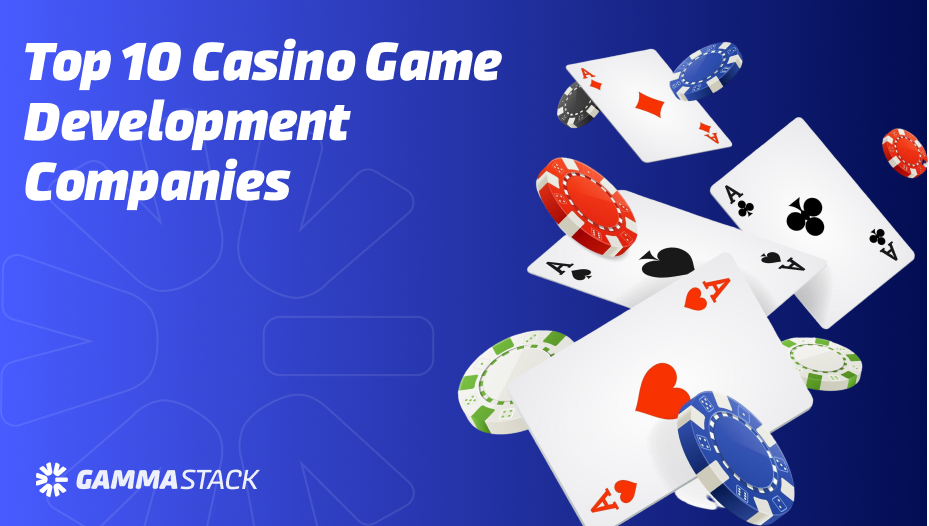
Share it
TABLE OF CONTENTS
- Understanding Casino Game Performance Optimization
- How High Traffic Impacts Casino Game Performance?
- Key Performance Metrics to Monitor While Optimizing Game Performance
- Strategies To Optimize Casino Game Development for High Traffic
- Benefits of Optimizing Casino Game Performance
- How To Test And Benchmark Casino Games For High Traffic?
- Why Choose GammaStack for Top-Notch Casino Games?
- Frequently Asked Questions (FAQs) on Casino Game Performance Optimization
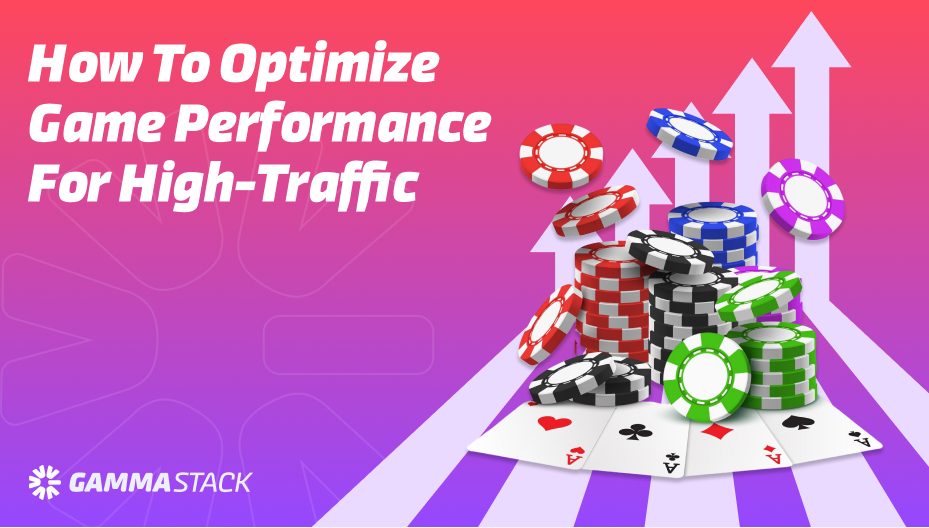
Casino Game Development: How To Optimize Game Performance For High-Traffic
As thousands of players log in simultaneously, ensuring seamless performance under heavy traffic becomes a critical challenge. From lightning-fast load times to minimizing server downtime, every millisecond matters.
In this blog, we’ll explore the strategies and optimization techniques that help online casinos handle high volumes of players while delivering an uninterrupted, engaging gaming experience.
Want to Know More About Casino Game Performance?
Understanding Casino Game Performance Optimization
For operators, performance isn’t just a technical concern. It’s a core part of their gaming KPIs, directly influencing player satisfaction, retention, and revenue. With the online casino market growing rapidly, a single glitch can make players switch to your competitors.
By applying targeted strategies, operators can meet performance benchmarks and deliver the fast, reliable experiences that keep players engaged.
Have a Casino Game Idea?
How High Traffic Impacts Casino Game Performance?

Increased Server Load
The high traffic strains the server and leads to slowdowns, server crashes, and poor user experience, which is unacceptable in any situation.

Increased Latency
A sudden surge in traffic can increase the latency, which refers to a delayed response from the game server to the player's action. The increased latency(Network, Processing, Rendering) significantly downgrades the user experience.

High Error Rates
The chances of error rates increase when more users are online and the server faces high traffic. This, in turn, leads to increased levels of game failures, payment failures, unstable gaming experiences, etc.

Lower Throughput
Throughput stands for actions that a game processes per second. Lower throughput and high latency impact player satisfaction and engagement during high-traffic conditions.

Database Overloading
High traffic leads to database overloading, primarily when too many requests exist. It slows down query processing, and sometimes the database crashes. For example, consider the scenario with more transaction requests for bets and payouts, but the database is not responding due to high traffic.

Delayed Performance Monitoring
To ensure the best user experience, real-time monitoring of the game's performance is a must. However, due to high traffic, real-time performance monitoring and incident response can become challenging for casino game operators.

Casino Traffic Monitoring
Failing to monitor casino traffic with cameras, sensors, and analytics can result in performance bottlenecks and gameplay delays during peak activity periods.
Have More Questions?
Key Performance Metrics to Monitor While Optimizing Game Performance
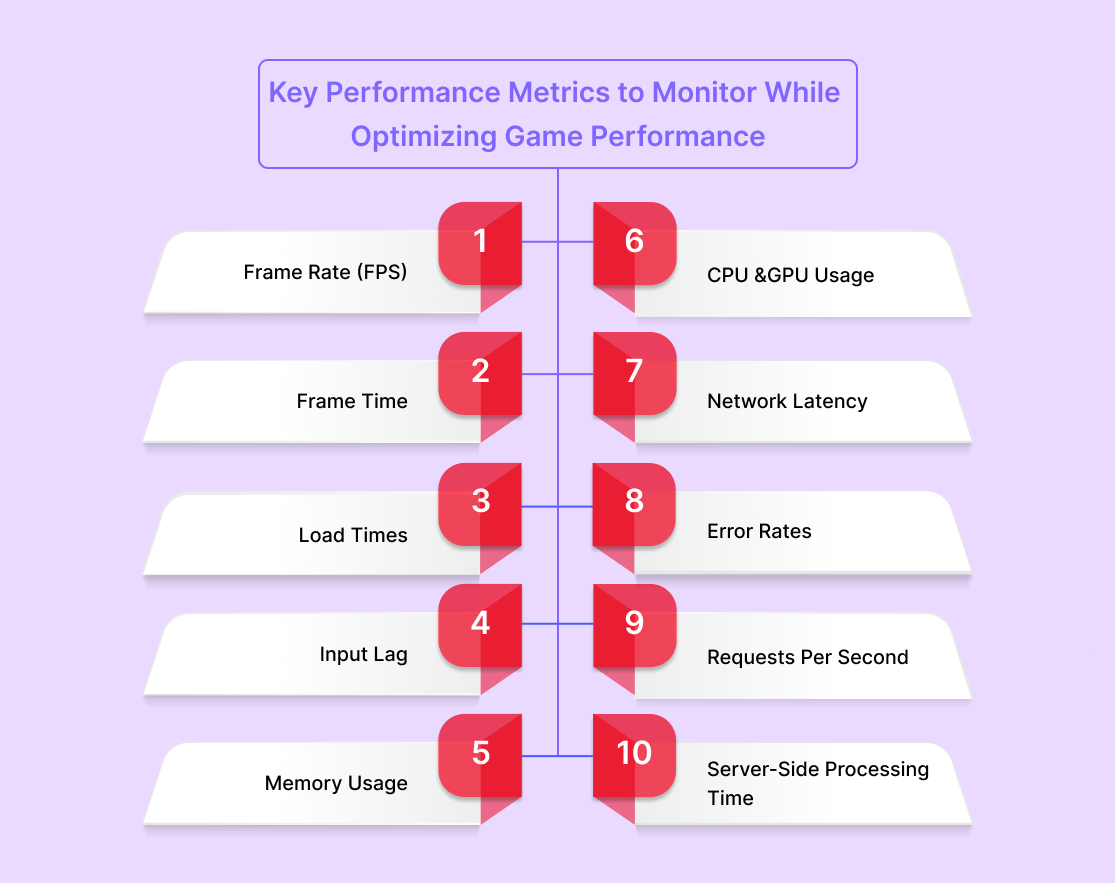

Frame Rate (FPS)
Indicates how smoothly the game renders frames per second. A minimum of 30 FPS is the minimum for smooth gameplay, with 60 FPS or higher targeted for premium experiences.

Frame Time
The duration required to render a single frame. Lower frame times produce higher frame rates (FPS) and smoother motion, while higher frame times can lead to choppy visuals or input lag, disrupting the gameplay experience.

Load Times
The duration required to launch a game or load new levels. Extended load times can frustrate players and reduce overall engagement.

Input Lag
The time between a player’s input, like a button press, and the corresponding on-screen action. Minimal input lag is crucial for responsive, accurate, and enjoyable gameplay.

Memory Usage
Represents the amount of RAM consumed by the game. Excessive memory usage can strain system resources, causing slowdowns, stuttering, or crashes.

CPU &GPU Usage
Monitoring CPU and GPU utilization helps detect processing bottlenecks that may cause lag or stuttering. High or inconsistent usage signals the need for optimization, whether in game logic or graphical workloads.

Network Latency
The time between a player’s action and the server’s response. High latency can lead to noticeable lag, severely impacting gameplay, especially in online multiplayer environments.

Error Rates
Track the frequency of errors or crashes that disrupt game performance and player experience.

Requests Per Second
Indicates how many requests the server processes each second, reflecting its capacity to handle player activity and game data.

Server-Side Processing Time
Measures how long the server takes to process a request before sending a response. Shorter processing times improve responsiveness and ensure smoother gameplay.
Readers of this blog also read
Strategies To Optimize Casino Game Development for High Traffic
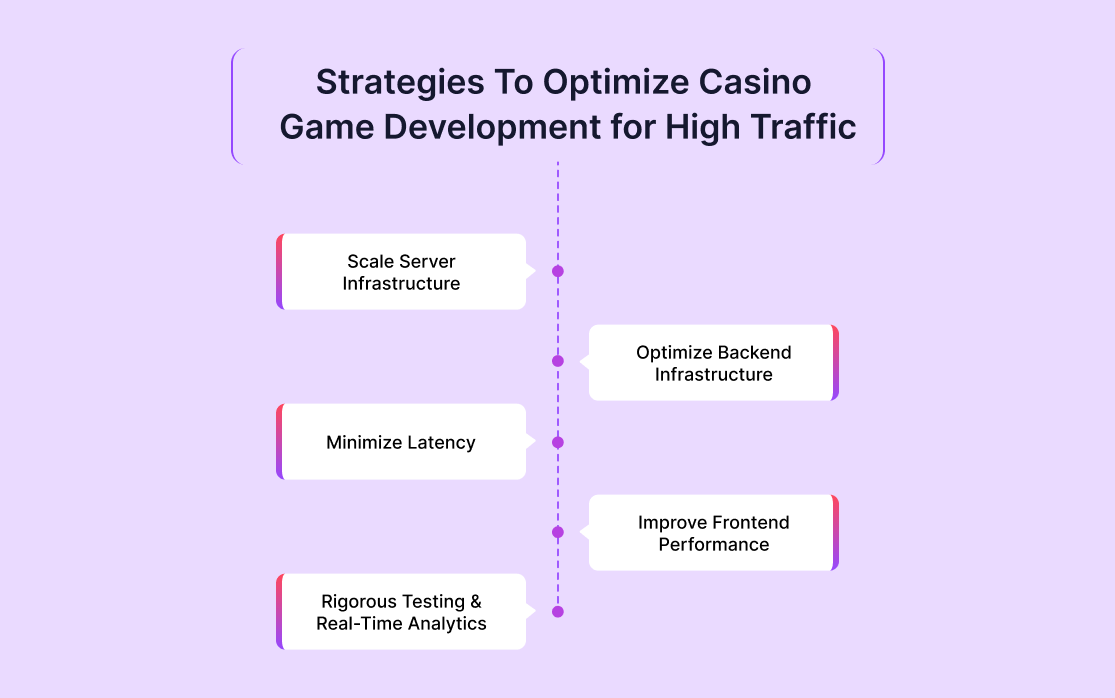

Scale Server Infrastructure
Implement load balancing to evenly distribute traffic across servers, preventing overload and ensuring responsiveness during peaks. Use auto-scaling to adjust server capacity in real-time, scaling with demand. Employ Content Delivery Networks (CDNs) to deliver cached game content from edge servers, reducing latency and load times globally.

Optimize Backend Infrastructure
Use microservices to independently scale game components. Apply asynchronous processing to cut player wait times. Optimize databases with indexing, partitioning, and caching, and consider distributed solutions for high transaction volumes.

Minimize Latency
Leverage edge computing to process data closer to players, minimizing latency and boosting reliability. Enhance networking by optimizing protocols, reducing data payloads, and compressing game assets to improve communication efficiency and lower bandwidth consumption.

Improve Frontend Performance
Refine game code for efficiency, compress assets such as images and audio, and use lazy loading to delay non-essential elements, improving initial load times. Ensure responsive design and seamless gameplay across devices to keep players engaged during peak traffic.

Rigorous Testing and Real-Time Analytics
Conduct load and stress testing to benchmark how the game and infrastructure handle high volumes of users. Use A/B testing to evaluate optimization strategies under peak loads. Monitor latency and server performance in real-time to detect and resolve issues promptly.
Explore More Blogs From Different Categories
Benefits of Casino Game Performance Optimization
- Seamless gameplay experience
- Improved retention rates
- High scalability
- Efficient resource utilization
- Reduced network bandwidth
Interested in Our Casino Games?
How To Test And Benchmark Casino Games For High Traffic?

Load Testing
Load testing refers to the process where quality analysts stimulate high-traffic scenarios to determine how the game responds to handle high-volume requests of users or to test the game's performance under heavy stress.

Stress Testing
Stress testing stands for testing the infrastructure by pushing it to its maximum limit and identifying the exact breakpoint. It allows casino game developers to analyze how much load the server infrastructure can handle before it fails.

A/B Testing
While performing A/B testing, different optimization strategies are compared to determine which works best during peak traffic.

Latency Testing
Latency testing measures the responsiveness of games under heavy traffic conditions. It covers testing of network latency, server response time, processing latency, and rendering latency. The ultimate goal is to ensure a smooth and responsive user experience.

Real-time Monitoring
Real-time performance tracking and monitoring of server and casino games helps detect issues as they arise and allows for swift actions to resolve them.
Looking for High- high-quality games for Your Casino Platform?
Why Choose GammaStack for Top-Notch Casino Games?
Our expert developers are well-versed in casino performance metrics and employ proven strategies to optimize game performance for high-traffic environments. With our support, you can ensure an engaging and uninterrupted gaming experience that keeps players coming back.
Frequently Asked Questions (FAQs) on Casino Game Performance Optimization
Providing a seamless, fast, and engaging gaming experience during high traffic boosts player satisfaction and trust, which directly helps optimize casino lead retention by encouraging players to return and stay longer.
When done properly, optimization improves system stability without compromising fairness or security. It’s crucial to maintain RNG integrity and implement secure, compliant practices alongside performance enhancements.
GammaStack is a trusted casino mobile games development company with a proven track record of providing real-time performing casino games. Here are some key advantages you'll have while working with us:
- Bespoke casino game development
- User-centric casino game design
- Intuitive UI/UX
- Cost-effective solutions
- On-time delivery and more
By streamlining backend processes, improving API efficiency, and using modular microservices, performance optimization can significantly reduce casino integration time, enabling faster deployment and smoother updates.
Optimizing game performance ensures that casino platforms remain fast, stable, and responsive even during peak user loads, preventing crashes, lag, and poor user experience that can drive players away.



